Pine Tar Soap Recipe | Dr. Squatch Copycat Recipe
This pine tar soap recipe is my version of Dr. Squatch Pine Tar Soap. It is manly, rugged, and smells absolutely amazing!
This post contains affiliate links
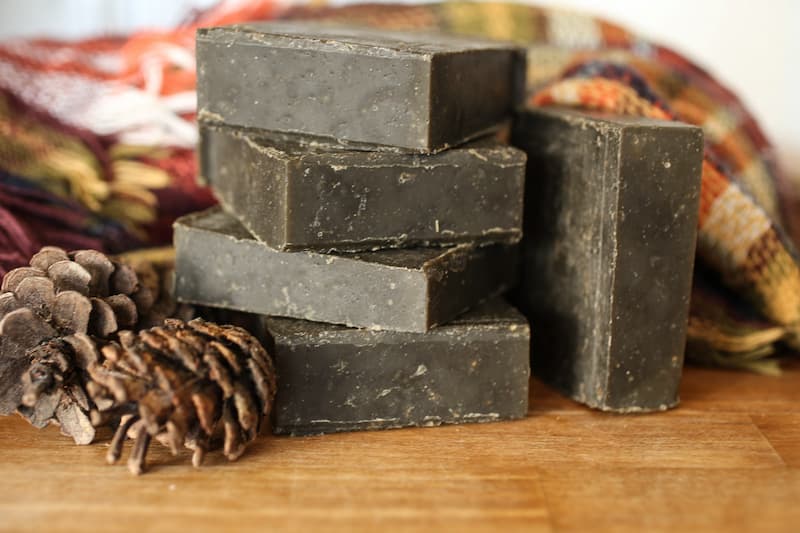
My 18-year-old son loves Dr. Squatch Pine Tar Soap. When he first brought it home I was so impressed, I thought, I have to learn how to make a soap like that! When I found out he was paying $6 per bar, I knew I should come up with a pine tar soap recipe! It really is great soap with natural ingredients, if you aren’t interested in making your own soap you should definitely buy a bar or two it feels and smells amazing!
While this soap is amazing, it is also a bit of a challenge to make. It took me three batches to get it just right! I’ll share all the details and all of my mistakes with you so that you can successfully make this soap!
There is also a video with this post, so it would be worthwhile to watch it as well! I take you step-by-step through the whole process!
Pine Tar in Soap
Pine tar is actually an age-old soap ingredient, known for its healing properties, it is the liquid from pine trees. Interestingly, it is great for treating psoriasis and eczema! Pine tar is antibacterial which is beneficial in keeping down body odor! Who knew?
Make sure whatever pine tar you purchase is creosote free. Check your local farm stores or get it on Amazon.
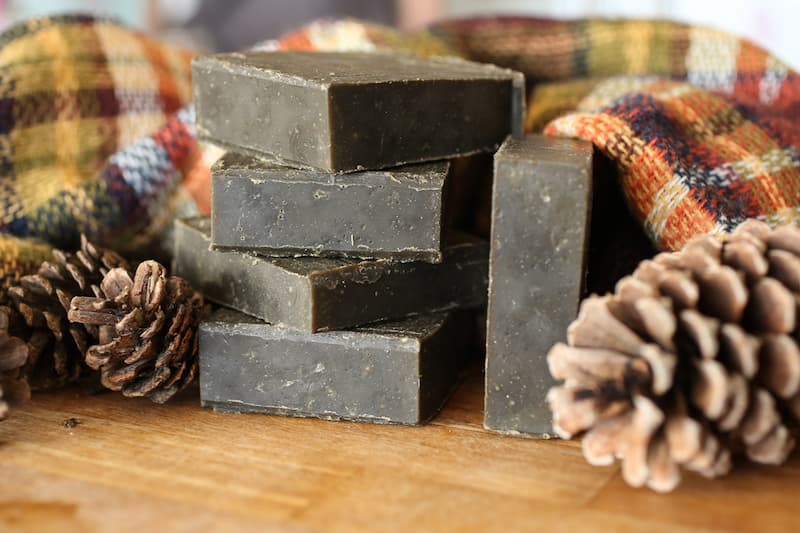
Tips for Avoiding Seized Soap When Using Pine Tar
The downside of using pine tar in a soap recipe is that it accelerates the process tremendously! My soapmaking friend warned me of this and I took precautions with my first batch of soap. For whatever reason on my second attempt, I didn’t take the same precautions and my soap seized. What is seizing? Well, it means the soap batter turns hard before you even get it completely mixed or in the mold. No fun! I am however glad it happened because I learned from the mistake!
The main thing to do to prevent your soap from hardening too quickly is to work at a low temperature and to mix by hand. No immersion blender is necessary for this recipe.
To keep the temperature low, I freeze the water before mixing it with the sodium hydroxide. This does the trick! Also, only melt the solid fats and butters, don’t heat the rest of the oils. Make sure the oils are cooled to around 85-90 degrees.
There is a lengthy list of additives for this soap, don’t be alarmed, it’s fun to add some grit to the soap! Measure out each ingredient and have it ready to go in little dishes. I know it’s a lot of dishes to dirty up, however, you will be glad you have everything ready and at hand.
Ingredients for Pine Tar Soap
- 10 oz coconut oil
- 7 oz olive oil
- 9 oz lard
- 2 oz shea butter
- 3 oz pine tar
- 1.5 oz castor oil
- 10.5 oz distilled or filtered water
- 4.5 oz sodium hydroxide (lye)
- 2 oz Essential oils (pine, cedarwood, and orange)
Pine Tar Soap Recipe Additives
- 1-1.5 TBS Pumice
- 3 tsp activated charcoal powder
- 2 tsp kaolin clay
- 2 TBS oats ground super fine
- 2 tsp sea salt
The pumice gives the soap that gritty feeling that exfoliates so nicely. The charcoal helps to pull out dirt and impurities and clear out pores. The kaolin clay is mixed with the fragrance and it anchors it making the scent last longer. This was my first time using kaolin clay in a recipe and I will say it definitely works! The oats are very nourishing for your skin. The sea salt helps the bar to harden.
Steps for Making Pine Tar Soap
- First, measure the 10.5 oz of water and pour it into ice cube trays and freeze it.
- Next, measure out each of the ingredients listed, and have everything ready
- Once frozen pour the measured sea salt over the ice, next sprinkle the sodium hydroxide on the ice as well. Gently stir while the ice melts, and set aside.
- Melt your hard fats and butters, remove from heat, and pour in the liquid oils and the pine tar, mix well
- Once oils are combined, add in the pumice, and the charcoal
- Then add the kaolin clay mixed with 1 tsp of water and the fragrance oils
- Test the temperature of the lye and the oils, each should be 90 degrees or under
- Pour the lye solution into the oils and add the oats
- Stir until you reach trace
- Pour into your prepared mold
- Cover and let sit overnight
- Unmold the next day, cut into bars and allow to cure for 4-6 weeks
Cost of Making Dr. Squatch Knockoff Soap
I’m not a math person, so this is my best estimate based on the cost per ounce of each ingredient. There are obviously a lot of ingredients in this soap. However, you will be able to make many batches of soap from most of the ingredients. Your initial cost of sourcing all of the ingredients could be quite high depending on what you have on hand.
I calculated the cost per loaf. My mold holds approximately 32 ounces and if I cut it properly I should get 8 bars of soap from the mold. If my math is correct the cost per bar is approximately $2.50. So there is actually quite a savings if you make this yourself versus buying the bars at $6 each!
Pine Tar Soap Squatch Knockoff
Equipment
- 1 Soap Mold 30 oz or larger
- 1 spoon
- 1 Digital Kitchen Scale
- 1 Set Nitrile Gloves
- 1 Goggles or Safety Glasses
- 1 Instant Read Thermometer
- 1 Set Measuring spoons
- 2 Glass Bowls
- 1 Rubber Spatula
- 1 Glass Measuring cup
Ingredients
- 10 oz Coconut Oil
- 7 oz Olive Oil
- 9 oz Lard or Palm Oil This is one case where you could use either palm oil or lard, the amount of lye used to saponify each is super close. Usually you can not switch out ingredients.
- 2 oz Shea Butter
- 3 oz Pine Tar Make sure it is creosote free
- 1.5 oz Castor Oil
- 10.5 oz Filtered or Distilled Water
- 4.5 oz Sodium Hydroxide (lye)
- 2 oz Essential oils I used a mix of pine, cedarwood and orange. 1 oz pine and .5 oz cedarwood and .5oz orange
Additives
- 1-1.5 TBS Pumice
- 3 tsp Activated Charcoal Powder
- 2 tsp Kaolin Clay
- 2 TBS Oats ground very fine
- 2 tsp Sea Salt
Instructions
- Safety: Wear long sleeves, rubber gloves, and gogglesFirst, measure the 10.5 oz of water and pour it into ice cube trays and freeze it.Next, measure out each of the ingredients listed, and have everything ready. Once frozen pour the measured sea salt over the ice, next sprinkle the sodium hydroxide on the ice as well. Gently stir while the ice melts, and set asideMelt your hard fats and butters, remove from heat, and pour in the liquid oils and the pine tar, mix wellOnce oils are combined, add in the pumice, and the charcoal. Then add the kaolin clay mixed with 1 tsp of water and the fragrance oils. Test the temperature of the lye and the oils, each should be 90 degrees or under. Pour the lye solution into the oils and add the oats. Stir until you reach trace. Pour into your prepared mold. Cover and let sit overnightUnmold the next day, cut into bars, and allow to cure for 4-6 weeks
Love Making Soap?
You can check out all of my soap-making posts here
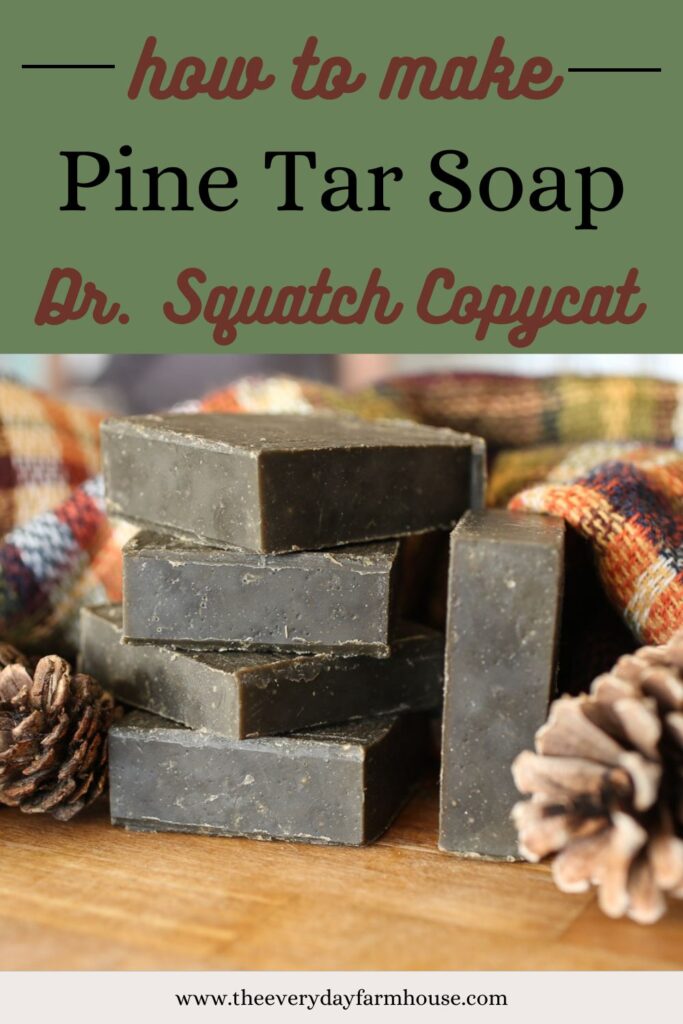
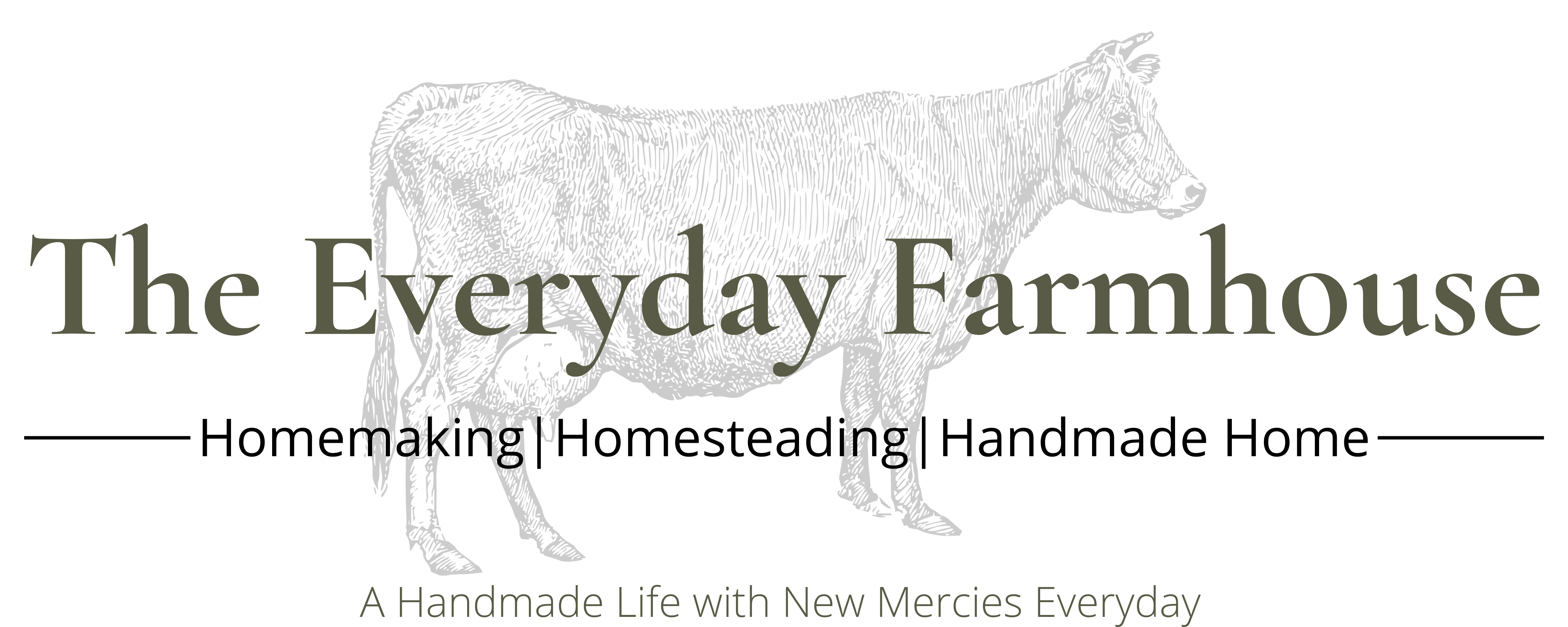
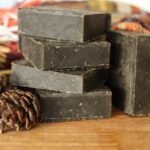
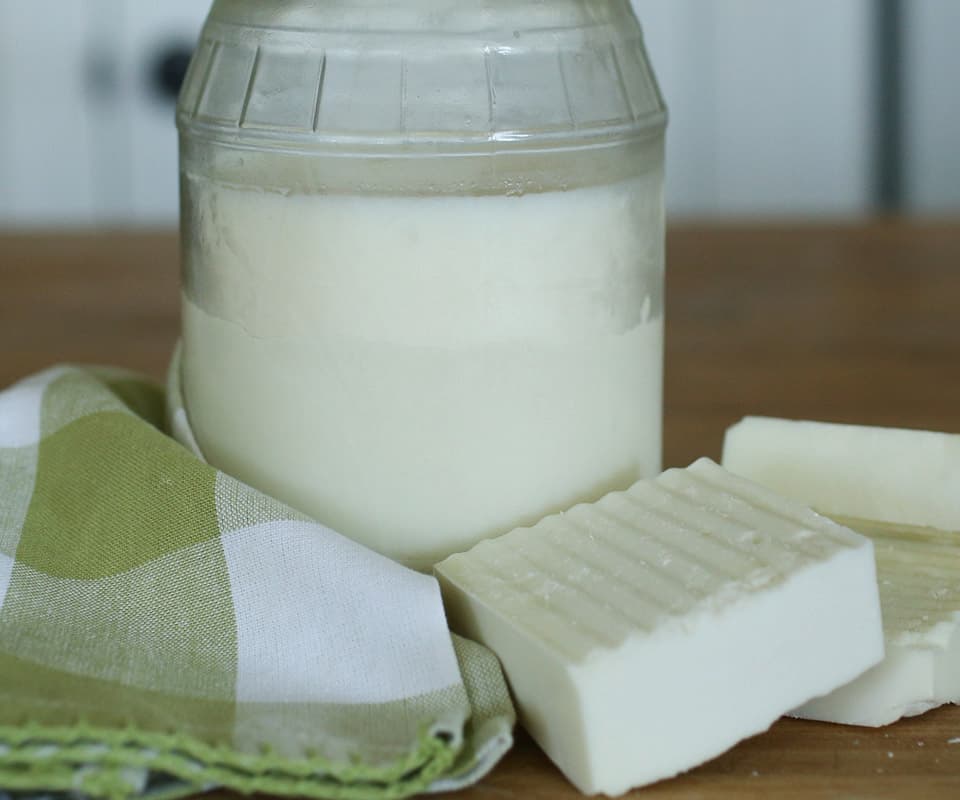
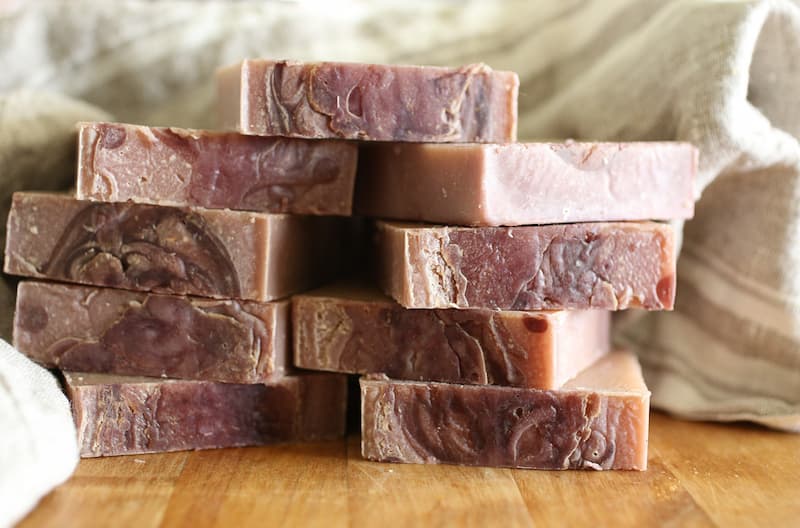

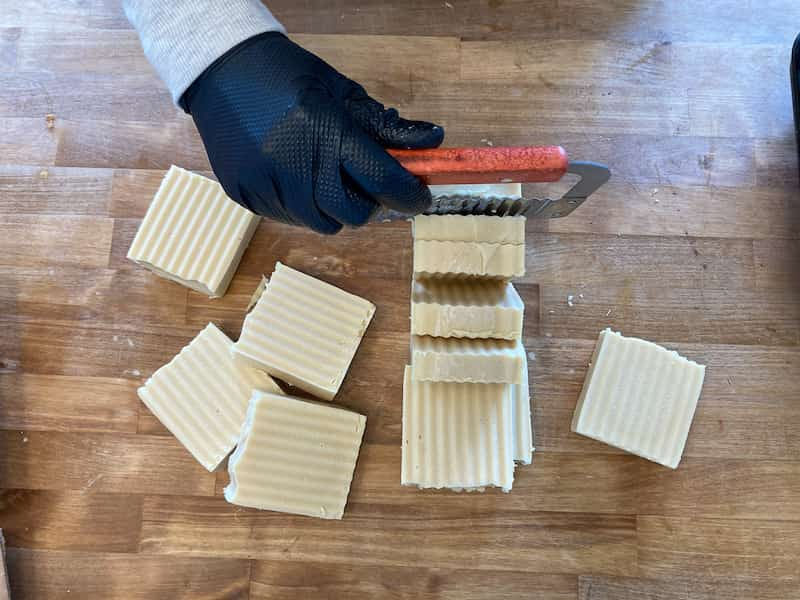
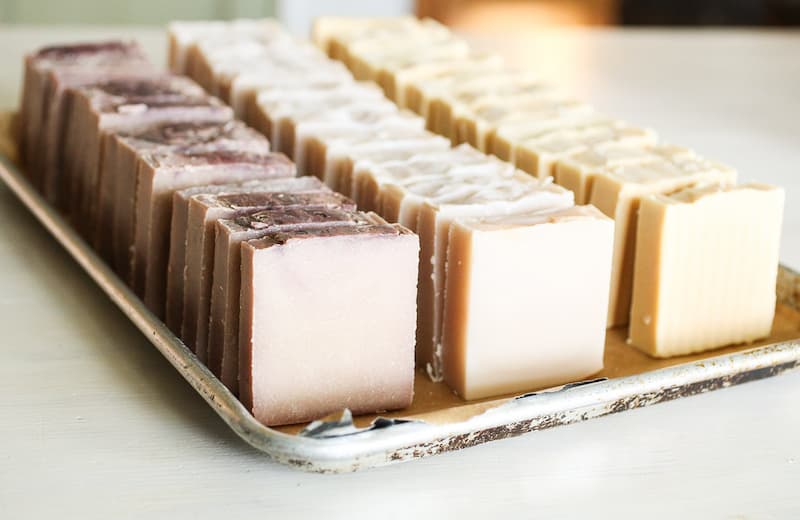
That sounds wonderful ♥️ Your Dad would like to buy a bar.
Please note: soap recipes are VERY SPECIFIC with regard to ingredients and they should NOT be altered without first checking with a soap calculator.
So, by that criteria, the “additives” are NOT optional, yes? It appears, by how the post was written, that they are optional, the fact they are NOT should be mentioned.
No fragrance oils in this, only essential oils which are much better and healthier for you.
This is a very nice recipe.
As far as the additives go, they can be optional, they don’t change the amount of lye needed. The saponification ingredients are the lye and the oils, you must always check a soap calculator if you plan to change any oils or any oil amounts as if you don’t the recipe could come out very lye heavy and burn you or it could turn out with too little lye. The additives like oatmeal, charcoal and pumice don’t change the amount of lye needed. I hope that makes sense. All that to say if you don’t want to add pumice it is fine to leave it out, the same with charcoal or oatmeal.
What are the exact measurements of the essential oils? Is it 2oz of each oil or 2oz total of combined oil? You mentioned it is primarily pine so I would like to get the scent right. Thank you!!
By the way, LOVE your blog!! I stumbled across it looking for a sewing project and got lost in your posts and found this soap recipe! Thank you for helping out a fellow homesteader with some fun winter projects!
Thank you so much! I am not terribly precise I do about 1 oz of the pine and then split the other ounce between the other fragrances! I hope that helps! The pine is definitely the primary scent!
do you have another source for essential oils? i can’t figure out how you were able to make the soap so cheaply! those oils are expensive
Yes, they are expensive now, they have gone up some. I do buy some locally that is a bit cheaper. The other thing that I calculated was the fact that you don’t use all of the bottle and you can make a few batches of soap with what you buy!
Would love to see a recipe for their fresh falls version? I am so obsessed with that soap.
I haven’t tried that one yet!
Hi,
I’m ready to try this recipe but Im wondering if the lard can be substituted by something else instead.
thx.
Palm oil could be a substitute, but you will need to run the measurement through a lye calculator as the lye amount will change slightly when you change out the lard.
Hi,
Are all these oz measurements by weight or fl oz? figured I’d double check. Also the castor oil links to neem oil on Amazon… are they interchangable?
Measured by weight. I will check the link, no not interchangable! Thank you!
I fixed the link, thank you for letting me know!
Thanks so much for your quick responses. I just made this batch and your instructions worked perfectly! Hopefully my last question.. how much does the scent change as it cures? Mine mostly smells like straight pine tar with some essential oil to it (I used 50/50 pine and cedarwood). Also, I saved money on the lard as I used beef tallow rendered from my brisket trimmings, which is nice.
I love that you used tallow! Interesting on the fragrance, mine literally smells like pine, the other oils are a bit lost. Perhaps the pine you used was not as strong? It’s hard to know. As it cures the fragrance may come out a bit more but not a lot.
I was so happy to read that you used tallow as that’s what I would like to try as well. Were you able to use the same measurements as the lard? Thanks so much!
The lye requirements for tallow and lard are very close but you should run any changes through a lye calculator just to make sure you are using the right amount. I’m glad you will be trying the recipe with tallow!
Hello! So I mixed the lye, salt and ice before mixing the oils, and the lue solution heated up. Do I just wait until the temperature of that drops? Thank you! I’m looking forward to the results!
When making this, I’ve made 3-4 batches with no issues at all (love this soap), however, I have had a couple of batches where there were a few small pockets of oil usually in the middle of the bar. Everything appears fine while bringing to trace, into the mold, however, when the soap sets up there are small pockets of oil. Any ideas as to what’s causing this? What can I do to correct this issue? Thanks
Hi there, I have a few ideas of what might be wrong. Perhaps because of the lower temperature you are reaching false trace and the mixture is not fully saponified. The other problem could be the fragrance oils, sometimes they can cause separation. To fix the already finished batches, you could heat it up like a hot process soap in a crock pot. Melt it all down again remix and remold. The bars will have a more rustic appearance but will be fine to use. If it’s a problem with the fragrance oils, you could try adding those in with the liquid oils and mix with the lye water, this would ensure they are getting mixed together fully. I don’t have a whole post on troubleshooting problems, I probably should, but I often refer people to this post from The Nerdy Farm Wife:https://thenerdyfarmwife.com/troubleshooting-cold-process-soap-problems/#:~:text=Solution%3A%20If%20you've%20recently,slow%20cooker%20to%20hot%20process. She may have some ideas that help you figure it out.
This is great! Love that smell!
Sounds like a great recipe for pine tar soap. What brand of pine tar did you use?
It is on Amazon and linked in the recipe